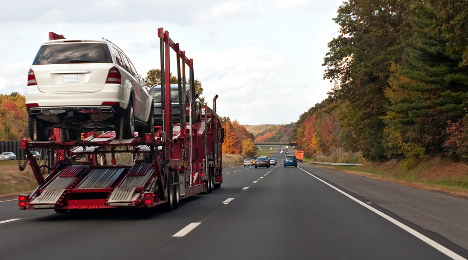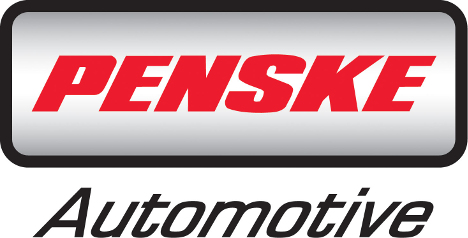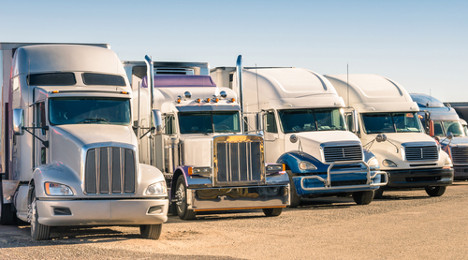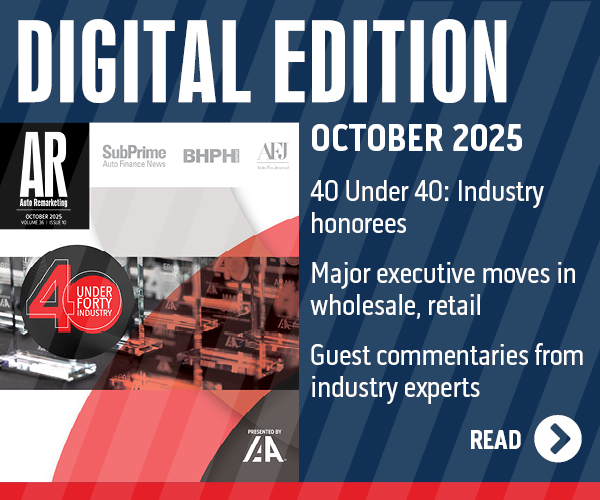Responding to industry demand for vehicle transportation that exceeds carrier availability, ShipCarsNow and Ready Auto Transport have formed an alliance to provide multi-modal car transport services.
By combining their truck and rail services, the companies aim to boost carrier capacity and provide transportation efficiencies for Manheim customers in the U.S. as well as other wholesale vehicle shippers. In addition to more capacity, the alliance can offer shippers more auction destinations and door-to-door shipment visibility.
The combination of Ready Auto Transport's truck and ShipCarsNow's rail transport services, the companies say, offers a more economical and efficient means to ship large car volumes.
“As wholesale volume continues growing, this collaboration will play a significant role in the remarketing industry’s movement of vehicle inventory,” said Jerry Tassone, president of Ready Auto Transport. “The combination of truck and rail solutions will offer increased capacity for our customers.”
ShipCarsNow president Marty Coalson added: “ShipCarsNow, working with Ready Auto Transport, allows wholesale auto shippers to leverage the ShipCarsNow rail network between key U.S. population centers and growth markets. In addition to more capacity, in certain areas rail transport can help a seller reach more markets than direct truck at a comparable price.”
If you need convincing of the capacity challenges facing the vehicle transportation industry, consider what United Road Services president and chief executive officer Kathleen McCann had to say during a keynote address at last month's NAAA/IARA/CAR Conference in Las Vegas.
As part of her presentation on “What’s Ahead in Car Haul … Capacity, Compliance, Customer Experience and Collaboration,” McCann posed this question amid sharing some market dynamics impacting capacity (including a growing supply of vehicles, among others): “So, are we short car haul capacity? As currently operating, I would say yes.
“And lest we tire of the historical warnings about capacity, driver crises and trucking crises, etc., and we sound a little bit like the boy crying wolf, I just tell you to remember, the wolf actually showed up,” she said. “It’s a real issue; we’re seeing it in real time.”
And it’s one that could continue as the “pipeline” of vehicles continues to grow given such factors as bulked-up used- and new-car sales. McCann said that, currently, research indicates the industry is approximately 3,000 car haulers short.
The deficit is, “not about manufacturing,” McCann would later emphasize.
“We know the truck manufacturers have been super busy, but there’s no challenge in getting trucks built, and the trailer manufacturers have additional capacity. So there isn’t a constraint there,” she said.
“So, if we’re short this many trucks and we know it’s not a manufacturing problem, then the real capacity issue is drivers,” McCann continued.
The overall shortage of drivers in the trucking industry (for car haul and otherwise) range from 35,000 (per an estimate from former Kansas Gov. Bill Graves, the president of the American Trucking Associations) “to much higher, depending on how you actually de ne a population of drivers,” she said.
Looking at some of the reasons for the “downfall,” McCann pointed to a few, including “extreme” driver turnover, an economic recovery that pushes demand, an aging driver population, a generational gap when it comes to interest in trucking, and ramped-up regulatory environment.
An additional factor, she said, is the requirement from customers to strap most new cars instead of chain them.
This, “combined with the increased tractor size due to the emissions systems have essentially reduced our load factor by half — which is one, because you can’t move half-a-car — and so we’re talking about a 10- to 15-percent capacity hit from that,” McCann said.
“These combined factors have been serving to increase the number of drivers that must be hired each year (in the general trucking industry) from 1 million in 2013 to 1.4 million by 2020,” she added. “That’s an estimated 40-percent bump and a very intimidating number.”
The latest action by Federal Trade Commission regarding online reviews didn’t fall within the spectrum of how a dealership performed; rather in connection with a segment of the wholesale space.
The regulator said AmeriFreight, a vehicle shipment broker based in Peachtree City, Ga., has agreed to a settlement with the FTC that will halt the company’s allegedly deceptive practice of touting online customer reviews, while failing to disclose that the reviewers were compensated with discounts and incentives.
Officials indicated the FTC’s complaint marks the first time the agency has charged a company with misrepresenting online reviews by failing to disclose that it gave cash discounts to customers to post the reviews.
“Companies must make it clear when they have paid their customers to write online reviews,” said Jessica Rich, director of the FTC’s Bureau of Consumer Protection. “If they fail to do that — as AmeriFreight did — then they’re deceiving consumers, plain and simple.”
The agency recapped that AmeriFreight is a vehicle shipment broker that arranges the transportation of units through third-party freight carriers. Its website touted that the company had “more highly ranked ratings and reviews than any other company in the automotive transportation business.”
As part of its advertising, FTC noted AmeriFreight encouraged consumers to “Google us ‘bbb top rated car shipping.’ You don’t have to believe us, our consumers say it all.”
According to the FTC’s complaint, AmeriFreight and its owner, Marius Lehmann, violated section five of the FTC Act by failing to disclose that they compensated consumers for their online reviews. Specifically, according to the complaint, the respondents:
— Provided consumers with a discount of $50 off the cost of AmeriFreight’s services if consumers agreed to review the company’s services online, and increased the cost by $50 if consumers did not agree to write a review.
— Provided consumers with “Conditions for receiving a discount on reviews,” which said that if they leave an online review, they will be automatically entered into a $100 per month “Best Monthly Review Award” for the most creative subject title and “informative content.”
— Contacted consumers after their cars had been shipped to remind them of their obligation to complete a review to receive the “online review discount,” and qualify for the $100 award.
— Failed to disclose the material connection between the company and their consumer endorsers — namely, that AmeriFreight compensated consumers to post online reviews.
— Deceptively represented that its favorable reviews were based on the unbiased reviews of customers.
The proposed order settling the FTC’s charges prohibits the respondents from misrepresenting that their products or services are highly rated or top-ranked based on unbiased consumer reviews, or that customer reviews are unbiased.
The settlement also requires the respondents to clearly and prominently disclose any material connection, if one exists, between them and their endorsers.
Furthermore, the FTC noted AmeriFreight also must maintain records of its advertisements and other relevant documents, and must deliver copies of the order to company principals, officers, directors, managers, employees and others.
Finally, the company must notify the FTC about any changes in corporate structure or affiliation with new businesses that could affect its compliance with the order, which will expire in 20 years.
The FTC vote to accept the proposed consent order for public comment was 5-0. The FTC will publish a description of the consent agreement package in the Federal Register shortly.
Interested parties can submit comments electronically by following the instructions in the invitation to comment part of the supplementary information section. The agreement will be subject to public comment through March 31 after which the FTC will decide whether to make the proposed consent order final.
“The commission issues an administrative complaint when it has ‘reason to believe’ that the law has been or is being violated, and it appears to the commission that a proceeding is in the public interest,” FTC officials said.
“When the commission issues a consent order on a final basis, it carries the force of law with respect to future actions,” they continued before adding that each violation of such an order may result in a civil penalty of up to $16,000.
The National Independent Automobile Dealers Association recently announced its newest National Member Benefit partner. Joining NIADA list is Montway Auto Transport, a rapidly growing company that serves all 50 states.
In just eight years, officials highlighted that Montway has grown from a small, family-owned transport broker to one of the largest auto transportation companies in the United States, averaging 5,000 to 6,000 auto transports per month.
Montway offers open and closed carriers, a free auto transport rate calculator for instant quotes and a state-of-the-art business-to-business portal, and specializes in customer service.
"Even though we've grown into one of the largest vehicle shippers in the U.S., we're still the same car moving company,” Montway president and chief executive officer Mike Mihailov said.
“We still work hard to earn the trust of each individual client and we still treat each automobile delivery like we’re hauling someone’s baby, because, in a way, we are,” Mihailov continued.
NIADA members can receive a discount of 10 percent or more, depending on the order, on Montway's transport services.
For more information, contact Asad Qureshi at (224) 300-5414 and ask for the NIADA member-only discount, or visit www.montway.com.
FCA Selects ICL to Manage Automaker’s North American Vehicle Transportation Network
In other transportation industry news, FCA — formerly known as Chrysler Group — recently selected Las Vegas-based ICL to manage the automaker’s North American outbound logistics supply chain, effective Aug. 1.
ICL will form a new company, which will be focused on coordinating and overseeing the transportation of Chrysler, Jeep, Ram, Dodge, Fiat and Alpha Romeo vehicles to dealers and other customers in the United States, Mexico and Canada.
The new company's main office will be located in Rochester Hills, Mich., near FCA in Auburn Hills, Mich.
In total, ICL will hire approximately 26 employees to support FCA. Candidates with prior experience working for a 3PL or automotive OEM in the automotive logistics, transportation management, or supply chain management fields who are interested in exploring career opportunities with ICL are encouraged to submit resumes to [email protected].
Established in 1992, privately owned ICL is a provider of cloud-based solutions designed specifically for the finished automotive supply chain. ICL's current clients include Itochu Automobiles America, Mazda North American Operations, Mercedes-Benz Canada, Mercedes-Benz USA, Mitsubishi Motors Canada, Mitsubishi Motors North America, Nissan North America, Porsche Cars North America, Toyota Canada, Toyota Motor Sales of America, Volkswagen Canada and Volkswagen Group of America.
Vehicle transport companies deal with numerous clients that purchase or sell vehicles at auctions and request help with shipping. Among these are many dealerships adding to their inventory and car rental companies looking to sell vehicles at auctions.
One factor that can impact the viability of auction purchases and/or sales is transportation costs. Maximizing loads and determining the best routes can help reduce your costs and improve your bottom line. When determining what types and how many vehicles to take to or purchase from auctions, consider load factors, weight and distance.
Load Factors
In general, most car haulers will average eight cars per load.
Passenger cars average eight to nine per load, depending on the size of the sedan.
For midsize vehicles such as minivans, the average load factor is seven.
For mixed loads of eight, the makeup can consist of four midsize vehicles and four cars, or five SUVs and three cars.
Most importantly, if you call for a shipping quote on a full truckload and then exceed the number of vehicles that can fit on that truck, the single car or cars left over will have a much higher cost of transportation on a per-unit basis.
Weight Factor
Per Department of Transportation regulations, the total weight cannot exceed a combined total of 80,000 pounds, which equates to 32,000 to 34,000 pounds of cargo weight.
The best advice we can offer is to contact an experienced vehicle transport company and let them know about the specific types of vehicles involved. The dispatcher should be able to advise you on whether or not the load will likely go over the weight limit.
Distance
As you might expect, the cost for a truckload moving freight to a major city or common truck lane will cost less than a shipment to a rural destination with smaller roads and more restrictions. Transit times will also be affected when traveling to and from a rural area. The Federal Motor Carrier Safety Administration’s Hours of Service Regulations currently stipulate driving a maximum of 11 hours after 10 consecutive hours off duty.
To learn more about other considerations for cross-country shipping, read my previous article here.
With the right knowledge, you can arrange efficient vehicle transport to save your dealership time and money, and get your new inventory on the lot quicker.
Martha Garcia-Perry is director of account management with MetroGistics.
Penske Automotive Group announced this week it has renamed its U.S.-based commercial vehicle dealership business to Penske Commercial Vehicles, US.
The company also revealed its choice for leadership of this newly defined business branch, picking Richard Shearing as the new president of Penske Commercial Vehicles, US.
Shearing is coming over from Daimler Trucks North America, where he was vice president of national accounts. Prior to that position, Shearing served as general manager of component sales and director of product strategy at Daimler.
Penske Automotive Group chairman Roger S. Penske said, "We are pleased to welcome Rich to the Penske Automotive Group team to help lead our commercial-vehicle efforts in the United States. His depth of knowledge and experience will strengthen our team and provide a guiding hand as we continue to build scale in the commercial vehicle business in the United States."
Shearing has experience with freightliner trucks, account management, strategy “and a proven track record of building strong customer relations making him well-suited to lead the company's U.S. Commercial Vehicle Dealership operations,” the company said.
Shearing will relocate to the Penske Commercial Vehicle headquarters in Dallas.
Here’s a little-known fact: the vast majority of new vehicles are transported by rail. When cars come off the line at the plant — or arrive at a port, as is the case for imports — they are hauled via enclosed rail cars to rail terminals.
Trains are responsible for the long haul, then trucks handle the short trip from rail terminal to local dealerships. The car you drove to work today? It likely spent some time on a rail car.
There’s a good reason for this. Railroads are the most efficient way to move large numbers of vehicles over long distances. But while about 70 percent of new vehicles are transported by rail, only a small portion of used vehicles take advantage of this efficient delivery network. This leaves a lot of room for remarketers to leverage a more affordable transport option.
So why don’t more used-car shippers take advantage of rail? Part of it is simply lack of awareness of the benefits of rail. Another part is the highly fragmented nature of used-vehicle shipments. It’s also true that railroads have gotten some bad press lately. This past winter, historic weather conditions combined with increased demand caused delays across the rail network.
But railroads have worked diligently to catch up. They’ve also been proactive about finding solutions for the past year’s weather challenges to better prepare for similar circumstances in the future. Railroads are investing heavily in locomotive, terminal and track capacity. Likewise, railroads have been purchasing more auto racks to keep up with increased demand.
What does this all mean for remarketers?
Used-car shippers can benefit from rail, too.
If new car makers can trust their vehicles to rail, so can used-car shippers. After all, the used car you’re shipping was likely transported by rail when it came off the assembly line. Like new-car shippers, used-car shippers, too, can take advantage of the economies of rail, especially when moving multiple vehicles.
ShipCarsNow makes it easy to take advantage of rail. As a wholly owned subsidiary of Union Pacific Railroad, ShipCarsNow provides multi-modal auto transport solutions, selecting the best combination of rail and highway service to meet shippers’ requirements for cost and transit time. By bundling multiple modes into a single, seamless service, we make sure remarketers get the best of both worlds.
Rail offers the advantages of capability and cost. The railroads are ready — they’ve been moving vehicles since the dawn of the auto industry. They have the capability, and they’re cost competitive. With rail, remarketers have the added advantage of leveraging available empty equipment as trains travel back to manufacturers to pick up new loads. That means even as OEM volumes increase, capacity should be available for used-car shippers.
Rail provides unmatched safety and quality.
Auto ramps are secure, lighted and guarded, and trains carry automobiles in fully enclosed rail cars. With Web-enabled tracking technology, you also get complete visibility of your vehicle shipment.
When motor carrier capacity gets tight and costs are on the rise, rail can provide both the capability and competitive rates remarketers seek for the transport of their vehicles. Now is the time to take advantage of the economies of scale rail offers.
Martin Coalson is president of ShipCarsNow (ShipCarsNow.com) and Insight Network Logistics (InsightNL.com). This column was featured in the Dec. 1 print and digital editions of Auto Remarketing as part of our Inside Logistics and Transportation Trends special section
As the economy has been improving and vehicle sales have been increasing, transportation companies have been getting more requests to coordinate cross-country shipments. More fleet procurers are finding good deals at auctions outside their usual purchasing region.
When shipping cross-country, factors like distance and weather definitely impact delivery dates. Alisha Bray, MetroGistics’ West Coast/Midwest dispatch coordinator, offers the following considerations to keep in mind when shipping cross-country.
Distance
Normal transit times for cross-country moves (coast-to-coast) are usually 7-10 days from pickup during normal conditions.The average transit for north-south shipments is usually 5-7 days once haulers are loaded.
Longer distances also increase the possibility of delays due to mechanical failure or more pickups and drop-offs along the route.
Any delay or cancellation can affect turnaround time of the load, as drivers take time to deal with customers and help resolve issues.
Other than that, just following normal Department of Transportation regulations for driving hours and conducting mandatory restarts will affect transit times.
Weather
Travel times can be affected greatly by inclement weather that occurs throughout the year. Winter is definitely the hardest time for haulers since they have to account for highway closures and dangerous driving conditions.
Transport through mountainous regions can cause significant delays, especially when the DOT mandates tire-chain requirements during snowy conditions.
Drivers can usually only run about 20-30 miles per hour when the chain rule is in effect. Drivers caught operating without chains when the rule is in place can be hit with steep fines.
Depending on how bad conditions are, an additional two to three days may be required for transport.
Breaking News
The recent omnibus spending bill to fund the federal government into 2015, approved by Congress and sent to the president, includes a rider that would suspend a portion of the 2013 Federal Motor Carrier Safety Administration hours of service (HOS) rule.
Sen. Susan Collins, a Republican from Maine, introduced an amendment that suspends a once-in-seven-days limit on the use of the restart, which was introduced in 2004 to allow drivers to begin a new 70-hour work week more quickly. Previously, truckers were required to be off-duty 48 hours between work weeks.
With the suspension of these rules, truck drivers will be able to spend a maximum of 82 hours a week on the road, as opposed to 70. This development is expected to shorten delivery times of cross-country vehicle shipments.
Martha Garcia-Perry is director, account management with MetroGistics.
Almost gone are the days of the “Wild West,” where carriers run over hours or hide true shipment statuses. Real estate has rapidly decreased for outfits lacking strong compliance, operations and CRM systems.
While it is obvious to see the strengths in more modern dispatch and tracking methods, the compliance piece is just as impactful.
Summer and fall of 2014 really underscore the fact that auto transportation costs are not entirely dependent on fuel-cost cycles. Especially in the Northeast/Southeast shipping routes, seasonal-resident transportation costs have risen (compared to any other autumn), while fuel prices have dropped lower than they’ve been in four years.
Why? What has changed?
The volume of vehicles needing transportation hase not drastically fluctuated. It’s capacity that seems to have decreased. Again, why?
The transportation industry has seen a dramatic escalation in regulatory enforcement, coupled with a steep rise in insurance premiums. Great for public safety and outfits taking ownership of vital responsibilities; bad for carriers operating outside the mandatory compliance rules.
Keeping up takes dedication and a substantial allocation of resources. Not keeping up will put you out of business. Electric on-board recorder rulings are just around the corner, and are already common practice for many leading carriers. The places for noncompliant carriers to hide are vanishing.
Big picture, the industry is undergoing a healthy purge of companies that have cut costs by skirting compliance necessities. This removal finally brings shipping costs to a rate that better reflect the costs of safely conducting auto transportation. But what about the consumer?
While taking a minor hit upfront, shippers greatly benefit from a far less risking pool of carriers, improving safety, service and decreasing inefficiency from problems associated with shady business practices.
Increased technological advancements will be most beneficial if they follow transportation culture trends towards increased visibility. This not only means using technology to bolster shipment tracking and communications infrastructure, but also means being savvy and transparent with safety requirements.
Carriers must recognize the imperativeness of utilizing the latest advancements to better communicate and manage everything from hours-of-service to fleet maintenance. If not, they may just find themselves left behind at the weigh-station.
Jeremy Louisos is Director of Business Development at PreOwned Auto Logistics.
Editor's Note: This story is part of the Dec. 1 print and digital editions of Auto Remarketing, our Inside Logistics & Transportation Trends issue. We turned to some of the top providers in the industry for an inside look at the state of the transportation business and to hear how they are bringing value to their customers. To read all the stories in this section, be sure to check out the special section in the Dec. 1 AR.
Even as recently as a year or two ago, being able to transport a car to a customer in seven to 10 days was an ideal target.
These days, however, that goal is more likely to fall in the three- to five-day range, depending on the distance the car is traveling, says Ready Auto Transport’s Jerry Tassone.
Tassone, president at Ready Auto Transport, talked with Auto Remarketing at this year’s National Auto Auction Association Convention in Boston, and shared his unique perspective on the transportation and logistics business.
Meeting the compressed days-to-deliver needs “really requires a heavy dependence on technology,” Tassone said, “and simplifying the process and communication with your accounts, so you know where the vehicles are.”
Not to mention, Tassone said, the transportation business is “heavily fragmented.” Small, independent carriers comprise approximately 70 percent of the business, he said, with the remaining 30 percent being larger carrier groups (the majority being asset-based).
Typically, many asset-based carriers focus on the new-car segment, but they’re beginning to shift their focus to pre-owned, Tassone said.
“Everybody wants to get into the used-car market,” he said.
Ready Auto is not asset-based, so the company tends to rely on a base of 6,500 qualified carriers. That being the case, Ready Auto Transport aims for a high-touch relationship with its carrier partners and creating tools that can benefit these partners in their operations.
“This past year and going into next year, we will invest millions of dollars in technology … to create a better and more efficient experience for our customers and our carriers as well,” Tassone said.
This underscores the importance for Ready Auto Transport of building tools that its carriers find useful in improving efficiencies, as the company also works with its parent Manheim as well as independent auctions.
As Tassone put it, the business is “just not a simple game” or about just moving a car from point A to point B.
In explaining his earlier point about a shift towards the pre-owned side, Tassone goes back to the car-sales crash of 2008 and emphasized how it impacted the transportation business, as well.
“A lot of auto carriers either disappeared, went out of business or switched over to freight,” he said. “It wasn’t until a year or so ago that there started to be a rebound in the used-car market.”
However, the smaller, independent carriers don’t have the same kind of access to things like new equipment or financing that an asset-based company might. Thus, the carrier-based segment has not grown at the same rate as the volume coming from the various accounts, Tassone explained.
Interestingly enough, this also highlights a challenge for the asset-based group. While they may be better positioned to get the equipment, they’re challenge is finding drivers, Tassone said.
He pointed to statistics from the Department of Transportation and the Department of Labor indicating there were 39,000 open jobs (at the time of the interview) in the trucking space. However, just 1,900 were filled in August.
“So, it is requiring owner-operators and larger carrier groups to consider paying higher annual salary and benefits to hire and retain good drivers, so that’s creating challenges within the transportation industry to keep the trucks rolling, so to speak,” Tassone said.
“One of the things we have to be thinking about — and our customers are thinking about it, for sure — is having the capacity to move the volume that they anticipate over the next few years,” he added. “When you’re relying on a carrier network, it’s important to see that grow.”
For Ready Auto Transport, it’s about being “integrated” into the process “to monitor carrier utilization and help our carriers understand what volume we can bring to them, so they don’t have to market for themselves,” Tassone said.
For instance, he said, it’s not uncommon to see this at an auction: carriers standing around the lane trying to drum up business.
But Ready Auto Transport aims to turn that into an opportunity for greater efficiency.
For example, carriers, in the very near future, can use the Ready Auto Transport’s online or mobile app tools to see which lanes the company has inventory in that matches the lanes they will be traveling.
“So, creating that kind of efficiency gets the independent operators from focusing on trying to find inventory and then move it, to just moving it,” he said. “And those are the tools we’re focusing on today.”
Editor's Note: This story is part of the Dec. 1 print and digital editions of Auto Remarketing, our Inside Logistics & Transportation Trends issue. We turned to some of the top providers in the industry for an inside look at the state of the transportation business and to hear how they are bringing value to their customers. To read all the stories in this section, be sure to check out the special section in the Dec. 1 AR.












